Microsoft’s latest Windows 11 Insider Preview Build 26220.7271 in the Dev and Beta channels brings with it a new recovery option that restores your PC to the exact state it was at a previous point in time. Microsoft calls it Point-in-time restore, and it works by creating automatic restore points of your entire system, including apps, settings, and local files.
Point-in-time restore works offline, as the restore points are stored locally on your PC’s SSD. It can restore the full system state within the last 72 hours (3 days). The best part is that fast recovery with restore points is simpler, and is capable of fixing driver issues, bad updates, or misconfiguration issues.
In our testing, Windows Latest found that the Point-in-time restore feature works as expected and recovered our full system settings, apps, and files.
What is Point-in-time restore in Windows?
Point-in-time restore is a new recovery system in Windows 11 and Windows 10 that uses Volume Shadow Copy Service to capture complete system states at fixed intervals.
A restore point is a block-level shadow copy of the entire MainOS volume that contains the operating system files, installed programs, settings, account data, and local user files. Because the restore point includes everything on the OS volume, it can return the PC to the exact state it was in when the copy was taken.
While System Restore focuses only on system files, registry settings, drivers, and certain executables, Point-in-time restore covers everything, including user data. System Restore also intentionally avoids copying documents and personal files.
Microsoft built the Point-in-time restore feature to give users a modern equivalent of a full rollback without any disk images or backup software.
How Point-in-time restore works
Point-in-time Restore is powered by Volume Shadow Copy Service. VSS is a Windows subsystem that creates consistent block-level copies of a volume even while the system is running. It freezes writes long enough to make an accurate copy, then resumes activity in the background.
VSS has existed for years for backup software, but Point-in-time Restore uses it in an automated way. Restore points are created automatically on a schedule, stored in VSS’s diff area, and retained for up to 72 hours.
If a user selects point-in-time restore when Windows boots into the recovery environment, the user will get an option to select the restore point they want. Since these restore points contain the entire system state, the restore process rewrites all blocks that changed since the last copy.
System Restore cannot do this because it only tracks changes to protected system areas. That is the main technical difference. Point-in-time restore performs a miniature full-disk rollback, but System Restore performs a targeted rollback of select system components.
How to enable Point-in-time Restore in Windows 11
As of now, the Point-in-time Restore feature is only available to Dev and Beta Insiders who have installed the KB5070307 update, and this, too, in typical Microsoft fashion, is hidden.
If you want to try it in your test machine, go ahead and register as a Windows Insider for Dev or Beta builds, and install the latest Preview Build 26220.7271.
After the update, go to Settings > System > Recovery

Select the Point-in-time restore option.
Turn on the toggle for Point-in-time restore.
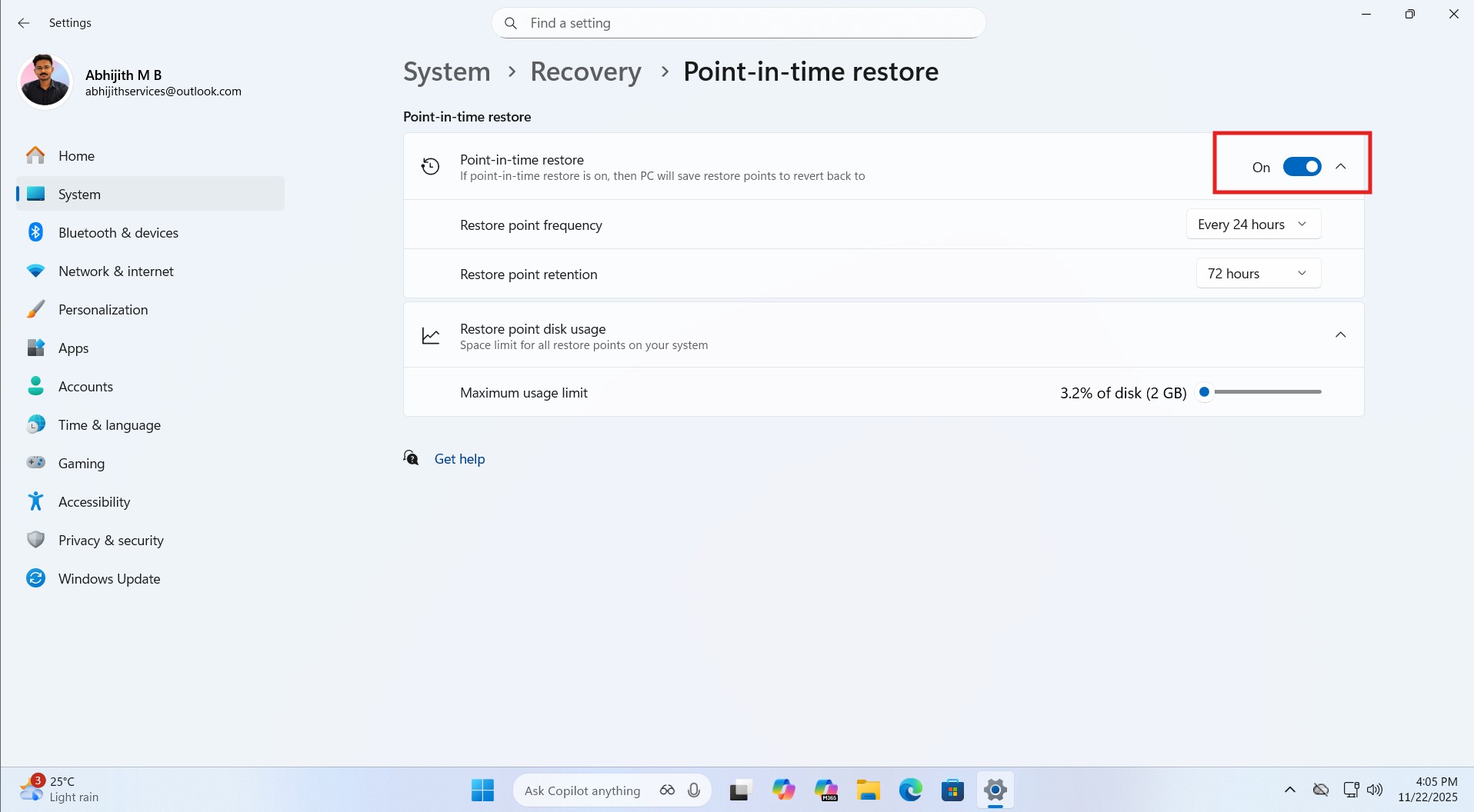
By default, the Restore point frequency is every 24 hours, meaning every 24 hours, your entire system will be stored in your PC.
Since this is your first time turning it on, the process will start immediately. After which, a scheduler will pick the next restore point based on your PC’s boot timing and the time of the last restore point.
You can customize the Restore point frequency to a lower time, starting with 4 hours. 24 hours is the maximum time that can be put between two restore points. You can choose 6, 12, or 16 hours.
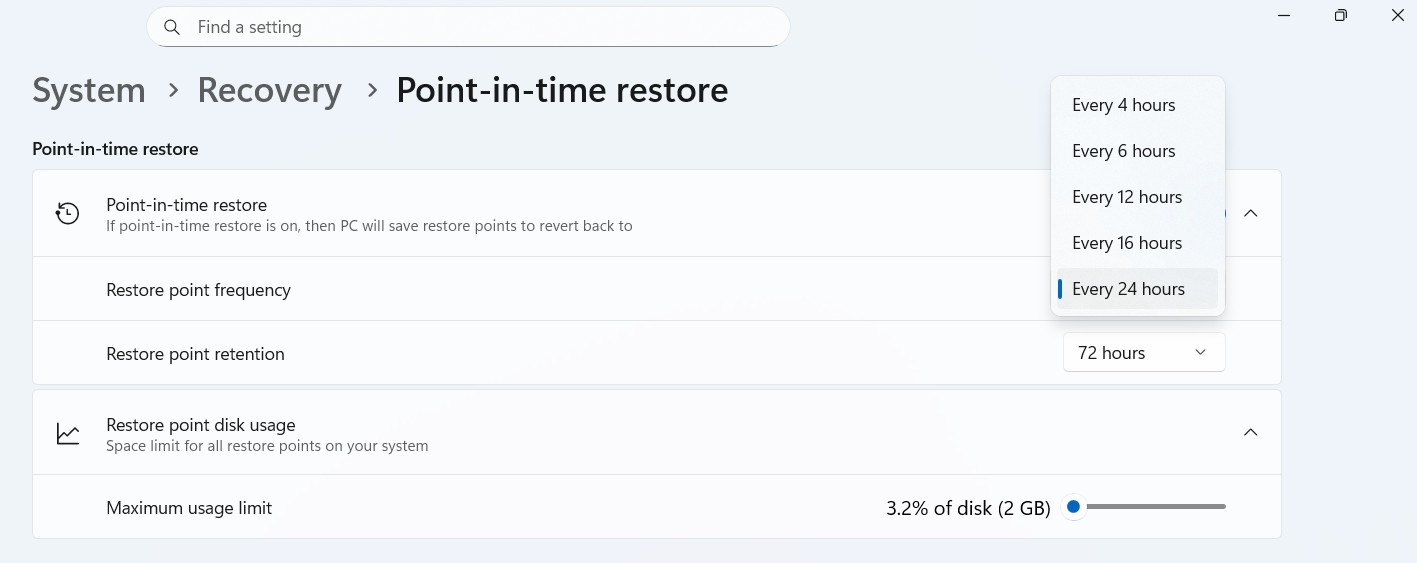
Whatever you choose, restore points will be created in the background, without interfering with your work.
The Restore point retention is set at 72 hours by default. It means that the retention point will be stored in your PC for 72 hours. Depending on your storage, the oldest restore point is deleted first.
You can choose a minimum restore point retention of 6 hours, with options from 12, 16, and 24 hours. The maximum retention period is 72 hours. A retention time of 6 hours means that the oldest restore point will be auto-deleted after 6 hours.
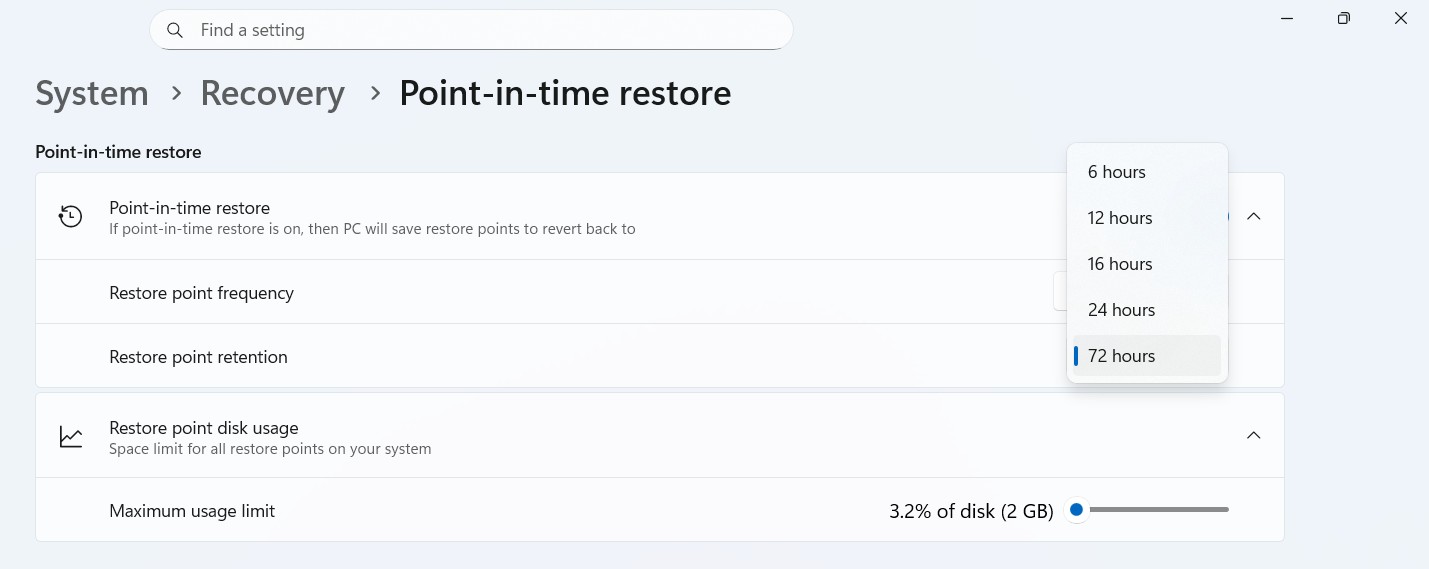
There is also a “Maximum usage limit” slider, which you can use to choose the amount of storage on your PC to store restore points.
Note that if you are low on storage, there may be an earlier deletion of restore points. Also, space is not pre-allocated or partitioned for restore points. Any remaining space within the maximum usage limit that is not used by restore points will be available to be used by your PC.
Microsoft also mentions that the Point-in-time restore feature will only be turned on by default if your PC has a total disk size of at least 200GB. Since my virtual machine has only 60GB of storage, the feature was turned off by default.
Test: Restoring a PC using Point-in-time restore
After enabling Point-in-time restore, you need to wait for some time for your system to create a restore point. Microsoft doesn’t give any indication of whether a restore point has been created or not, because it is supposed to happen in the background.
To test Point-in-time restore, you need to enter WinRE. For that, go to Settings > System > Recovery > Advanced startup. Click Restart now.


From WinRE, select Troubleshoot.
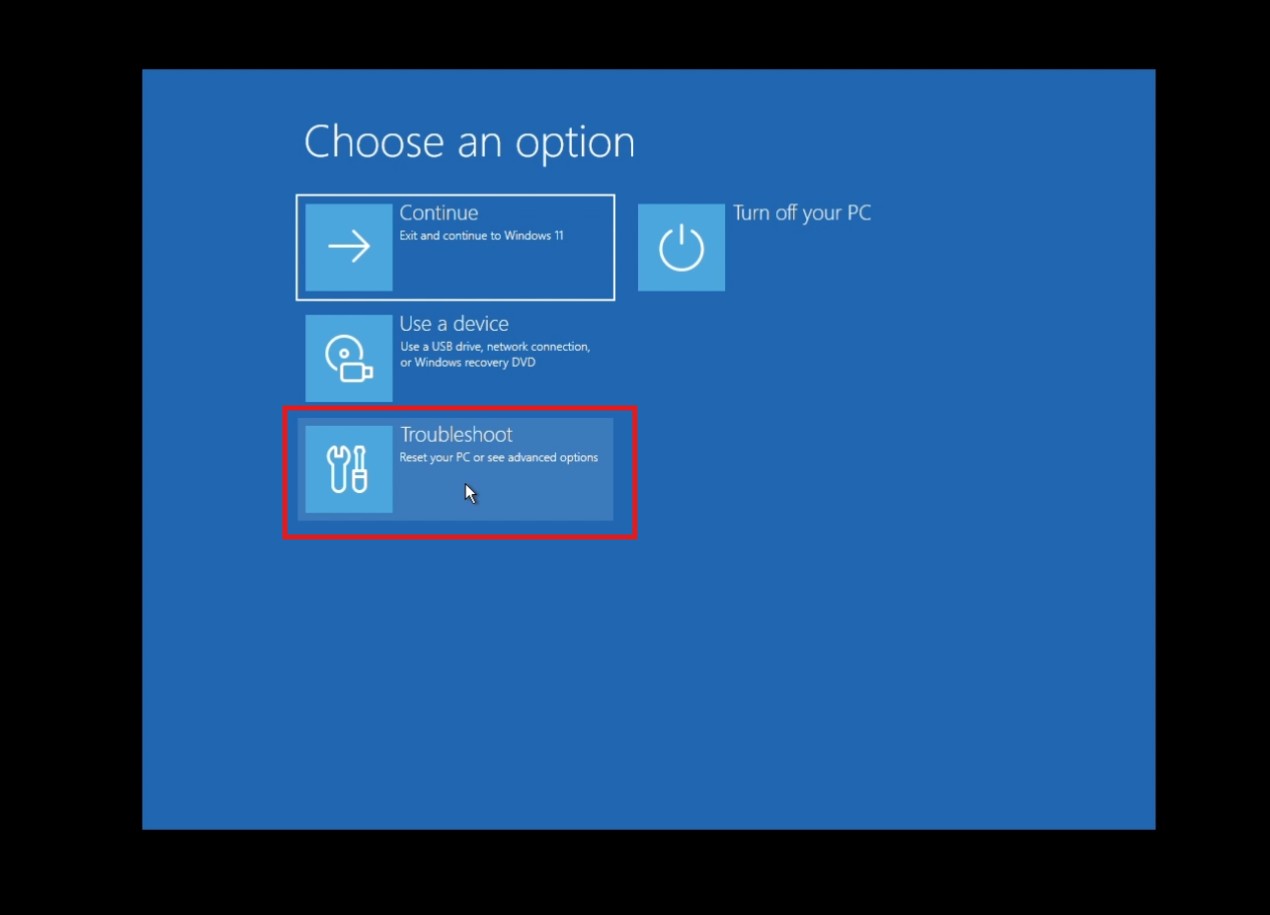
From the Troubleshoot options, click Point-in-time restore.
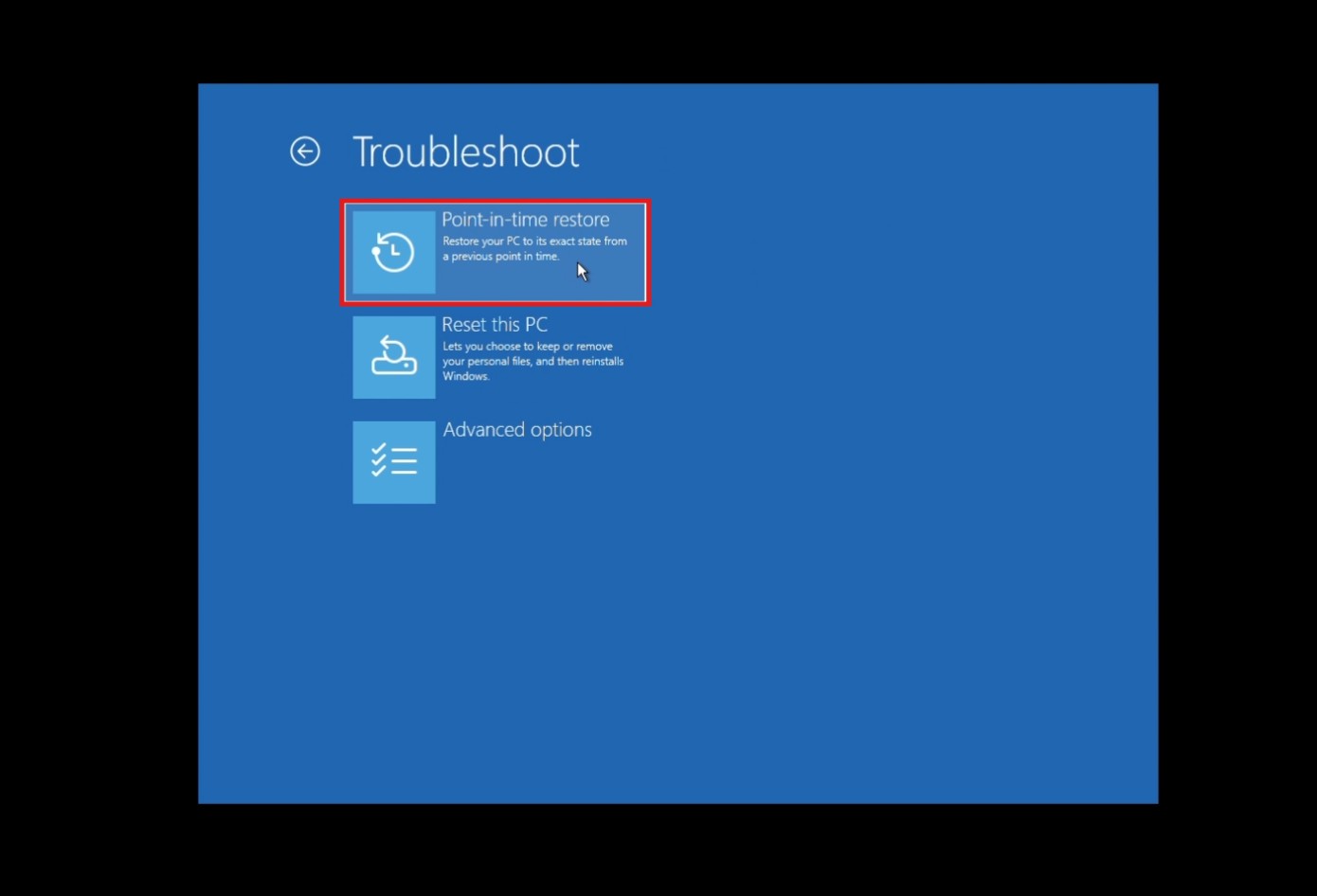
You may be asked to provide your BitLocker Recovery Key if you have encrypted volumes, which you can get from https://account.microsoft.com/devices/recoverykey.
You’ll now be shown the different restore points. Since this is the first time I have enabled it, there is only one restore point. Click on the restore point that closely matches the time you want your system to restore to.

Microsoft will show you a warning that says any data that you created after the time mentioned in the restore point will be lost. Click Continue.
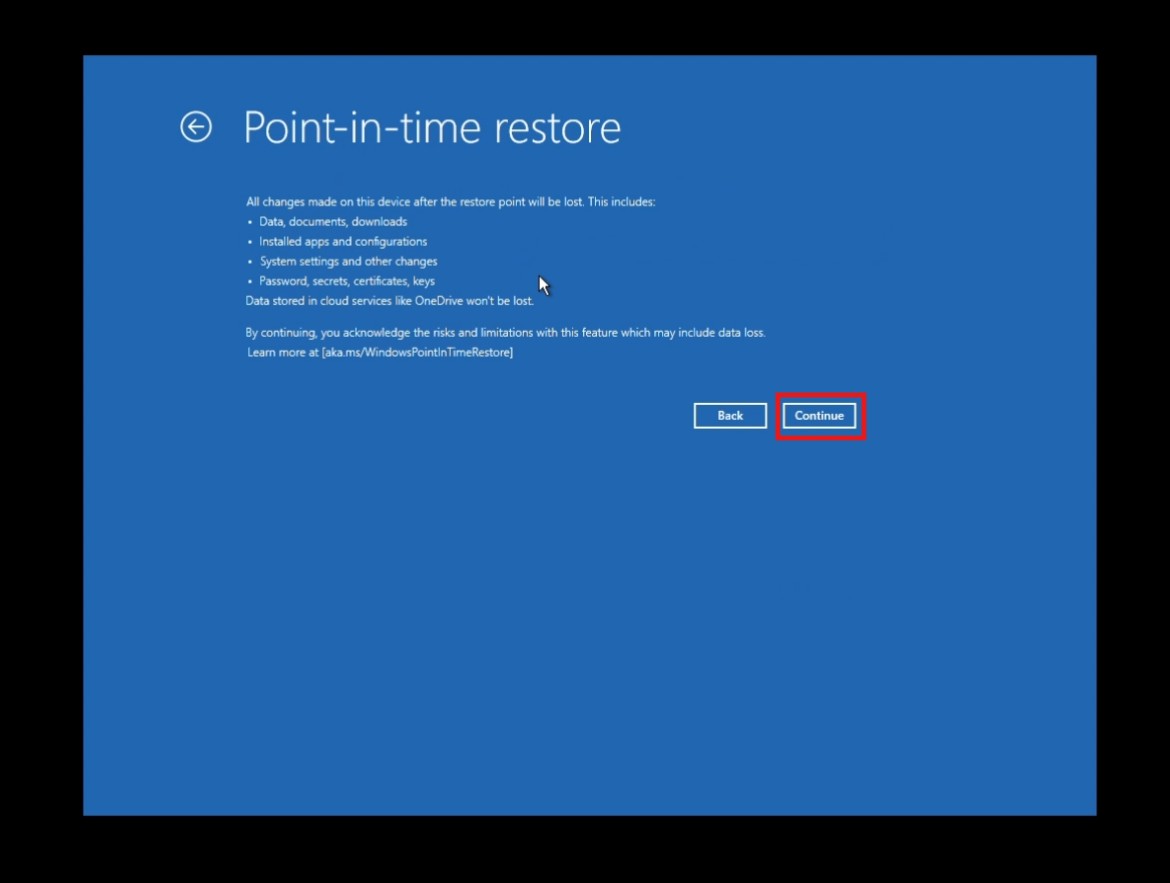
Check the restore point selection and OS version. Microsoft gives a final warning of data loss. Select Restore to start the restore process.
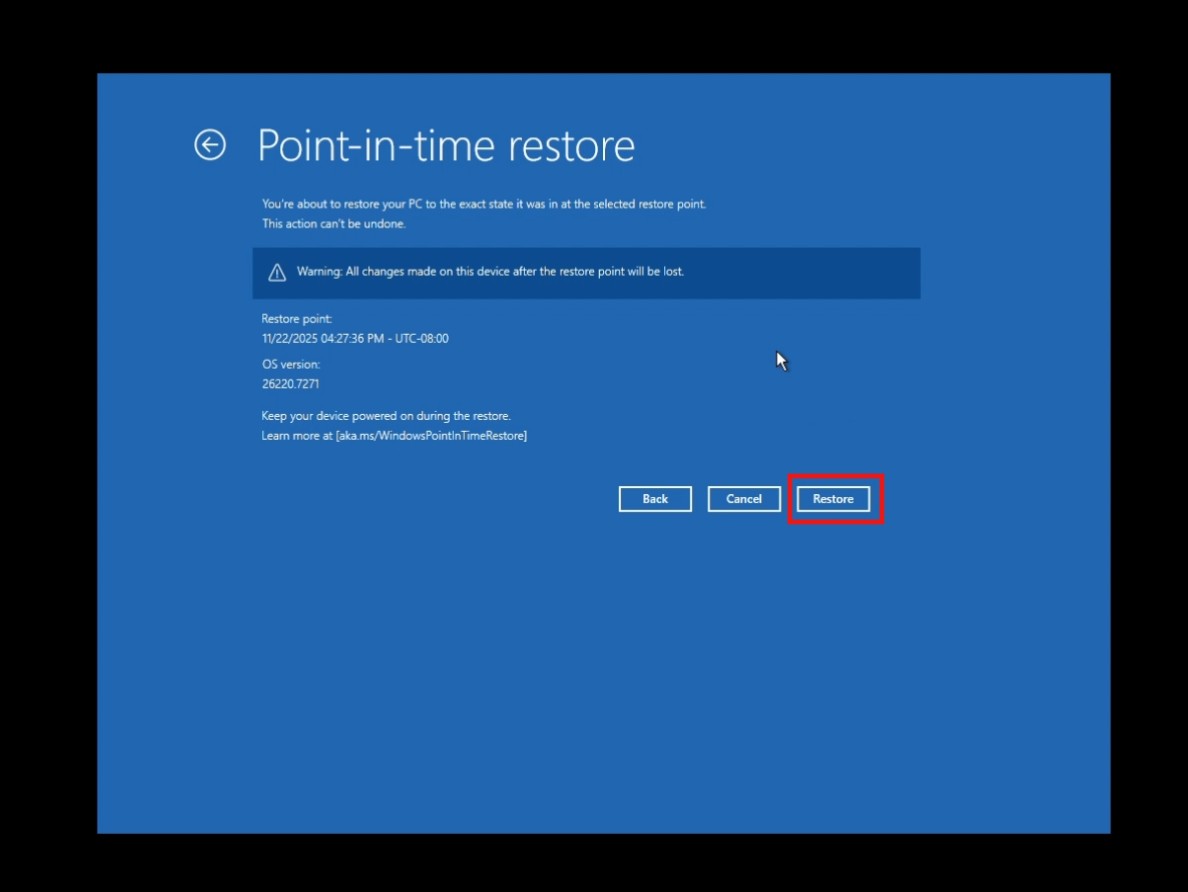
The restoration process will take a fair bit of time, depending on the number of apps and files you have. On my PC, it took around 30 minutes to restore completely, even though it had very few apps.
After the restore is complete, your PC boots back into Windows 11, without losing any apps or files.
Limitations and risks of Point-in-time restore
Point-in-time restore rewrites the entire MainOS volume to an older state. So, every change made after the restore point, including user files, application data, passwords, encryption keys, and certificates, is lost.
If you create or edit a document after the restore point, it will not survive. Since Microsoft doesn’t show when the restore points store data, it will be difficult to know if important data will be part of a restore point.
VSS itself can fail to create restore points if your storage is almost full, when the system is under heavy input and output load, or when the VSS writer becomes unstable. Point-in-time restore can also fail if there is not enough free space to stage the restore or if a corrupted file system prevents VSS from completing the rollback.
Windows cannot guarantee restore points will be created exactly on the chosen schedule because the system might be off or in sleep mode.
Restoring across different Windows editions, for example, moving from Home to Pro and back, can break the installation. VSS also struggles with encrypted EFS files and may fail to restore them reliably. If you have several partitions, only the MainOS volume is rolled back. Restore points cannot be exported, mounted, or browsed like disk images. They are internal VSS objects only.
It’s good to see Microsoft taking efforts to fix issues in Windows, but of course, this wouldn’t be necessary if Windows didn’t crash in the first place. But that is how Microsoft works, and it’s evident even with the File Explorer, where Microsoft decided that preloading File Explorer would make it faster, instead of fixing lags inside it.
The post I tested Windows 11’s Point-in-time Restore and it’s one of the best features without AI appeared first on Windows Latest




